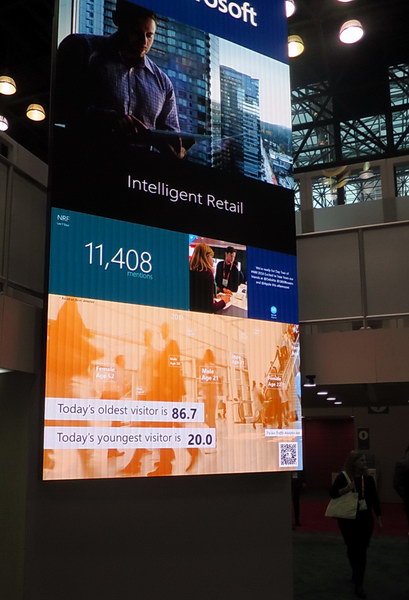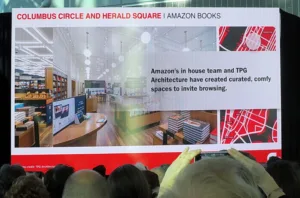Amazon Books has opened two retail locations in New York. (Credit: Retail Design Institute)
While at the NRF’s Big Show, I focused on the vendors, not the talks, in part because the talks were aimed more at the marketing aspects of retail rather than the technical aspects.
One talk in the Innovation Lab I did attend was titled “New NYC stores worth a visit!” and was presented by the Retail Design Institute. While I haven’t made it to any of these stores yet, several seem to incorporate innovative display and touch technology into the store design. These included the Hersey’s and T-Mobile stores in Times Square that feature outstanding and interactive digital signage; the Sephora store in Herald Square that features interactive tutorials on make-up, plus virtual application of make-up so a customer can see if the color matches the customer’s natural colors; and the Adidas store in midtown where AR/VR technology allows you to test Adidas footwear by running around New York City without leaving the store.
Since Amazon has set up a brick-and-mortar bookstores in Herald Square and Columbus Circle, these are worth a visit, technology or no. I suspect, however, at the minimum, the stores offer endless-aisle technology. Amazon with brick-and-mortar book stores? Book stores were Amazon’s first on-line venture so maybe this is a trend in its own right. Physical stores have felt very threatened in recent years by Amazon and other on-line retailers but maybe the pendulum is starting to swing the other way, driven partly by omni-channel and endless-aisle approaches to on-line and in-store shopping. (Amazon Opens First Checkout-Free Supermarket to the Public)
Time permitting, perhaps I’ll get to these stores later this spring. Hopefully before next year’s Big Show, to be held January 13 – 15, 2019.
Touch screen displays can’t really be described as a “trend going forward.” Instead, it is a trend from past years that has reached nearly 100% penetration in the retail market. In addition to POS terminals and other traditional retail functions, touch screens enable new retail applications for displays such as the endless-aisle concept. Clearly touch screens will not go away anytime in the near future. Anyone wanting to sell a display into the retail market needs to make sure it is touch-enabled. At NRF’s 2017 Big Show, I talked to a vendor who had deliberately changed his touch technology to match smartphone touch, to give customers a more familiar feel. In addition to now universal touch screens, the touch system suppliers should look into non-display applications of touch systems, a few of which were demonstrated at NRF. That may be the touch trend going forward – touch in non-display applications with real objects. (and a trend in automotive at CES – Man. Ed.)
I did not see any voice control systems at the NRF, so you certainly can’t call voice control a trend in retail going forward – yet. As voice control software and systems improve, I can see multiple applications for it in the retail environment. For example, it might simplify endless aisle applications and might be usable in dressing rooms. These applications may only be usable when the store is relatively quiet and the customer is not asking for extremely personal items they don’t want other shoppers to hear. For these and other reasons, such as the variety of languages and accents used by shoppers, I can’t see voice control replacing touch screens, only complementing them.
 Analytics in the Microsoft booth at the end of NRF’s Big Show, enabled by facial recognition. (Credit: M. Brennesholtz)
Analytics in the Microsoft booth at the end of NRF’s Big Show, enabled by facial recognition. (Credit: M. Brennesholtz)
Virtually every exhibitor at the NRF Big Show was showing at least some products that could have fit under the “Analytics, Big Data and Image Processing” headline. If I had to choose a single trend from the NRF, I would say it was the widespread application of computer vision and image processing as an input to analytics, big data and store management. When I went to NRF’s 2017 Big Show, machine vision in the retail environment didn’t seem mature enough or otherwise ready for widespread field installation. This year I got no such feeling – vendors were not only talking about what vision technology could do for retailers who hadn’t implemented it yet, they were talking about installations in retailer’s stores and how those installations had improved sales figures, mostly through increased conversion rates.
Another trend I saw was related to the of analytics for in-store use, not just on-line. Again, this trend is largely enabled by improved image processing and facial recognition. –Matthew Brennesholtz

